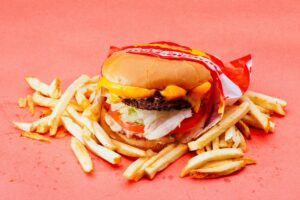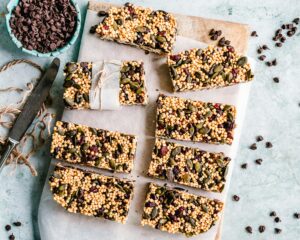When it comes to weight loss, what you eat matters as much as how much you eat. Achieving your desired weight isn’t just about cutting calories but also about choosing the right kinds of foods. While many of us focus on foods to add to our diet, we often overlook foods that can hinder our progress.
In this detailed guide, we’ll explore some common and not-so-common foods to avoid if you’re aiming to lose weight and maintain a healthy lifestyle. We’ll also discuss the science behind why these foods can be detrimental to your weight loss efforts.
1. Sugary Beverages (Including Diet Soda):
Most people know that soda, energy drinks, and sugary coffee beverages are full of empty calories, but did you know that diet soda might not be much better? Even though diet sodas are low-calorie, they often contain artificial sweeteners that can increase cravings for sugary and high-calorie foods.
- Why to avoid: Sugary beverages are packed with calories that don’t satiate hunger. Consuming liquid calories doesn’t trigger fullness signals in the body the same way solid foods do. This can lead to overeating later. Additionally, excess sugar can cause insulin spikes, which lead to fat storage.
- Alternative: Opt for water, herbal teas, or flavored water with a splash of lemon or cucumber to stay hydrated without the added sugar.
2. Refined Grains and Processed White Bread:
Refined grains, such as white bread, pastries, and certain crackers, are stripped of fiber and nutrients. These types of carbohydrates cause a rapid spike in blood sugar levels, which can lead to increased fat storage and hunger shortly after consumption.
- Why to avoid: Refined grains have a high glycemic index, meaning they cause a rapid rise in blood sugar levels. When blood sugar levels spike, the body produces more insulin, a hormone responsible for storing fat. This can not only make you feel hungrier, but also increase fat storage, especially around the belly.
- Alternative: Choose whole grains like quinoa, oats, brown rice, and whole-wheat bread. These contain more fiber, which slows digestion and helps keep you feeling fuller for longer.
3. Fried Foods and Fast Food:

Fried foods, including French fries, fried chicken, and other fast food items, are often high in unhealthy fats and calories. While occasional indulgence is fine, these foods can quickly add up in terms of calorie intake, derailing your weight loss goals.
- Why to avoid: Fried foods are typically soaked in oils that contain trans fats and unhealthy saturated fats. These fats not only contribute to weight gain but can also increase your risk of cardiovascular disease and other health issues. Furthermore, they lack the essential nutrients your body needs to feel satisfied, leading to overeating.
- Alternative: Grilling, baking, or steaming your food are healthier cooking options. Opt for healthy oils like olive oil or avocado oil when necessary.
4. Processed Meats:
Processed meats like bacon, sausages, hot dogs, and deli meats are often packed with unhealthy fats, sodium, and preservatives. They are also calorie-dense, meaning they can add up quickly in your daily intake without providing much nutritional value.
- Why to avoid: These meats are high in unhealthy fats and salt, both of which can contribute to weight gain, high blood pressure, and increased risk of heart disease. The preservatives used in processed meats, such as nitrates, have also been linked to increased cancer risk.
- Alternative: Opt for lean meats such as chicken breast, turkey, or plant-based protein sources like beans, lentils, or tofu.
5. Store-Bought Salad Dressings:
While salads are generally considered a healthy meal choice, many store-bought salad dressings are loaded with sugar, unhealthy fats, and empty calories. These dressings can quickly turn an otherwise nutritious salad into a calorie bomb.
- Why to avoid: Commercial salad dressings often contain hidden sugars and artificial additives. They may also use unhealthy oils like soybean or canola oil, which are linked to inflammation and weight gain.
- Alternative: Make your own dressings using healthier fats, such as olive oil, lemon juice, balsamic vinegar, or avocado. Adding herbs and spices can boost the flavor without extra calories.
6. Highly Processed Snack Foods:
Chips, candy bars, and packaged snacks are often marketed as convenient, but they tend to be high in calories, refined sugars, and trans fats. These snacks may be low in nutrients, which means they won’t keep you full for long, often leading to mindless snacking.
- Why to avoid: These snacks cause blood sugar spikes and crashes, leaving you feeling sluggish and more likely to reach for more junk food later. They also provide little to no satiety, meaning you’re likely to overeat.
- Alternative: Instead, choose whole foods like fresh fruit, vegetables with hummus, or a handful of nuts for a satisfying and nutrient-dense snack.
7. Granola Bars (Especially Store-Bought Versions):

While granola bars are often marketed as a healthy snack, many store-bought versions are loaded with added sugars and processed ingredients. What’s marketed as a “healthy” snack can often be a sugar-laden treat in disguise.
- Why to avoid: Many granola bars contain high amounts of refined sugar and unhealthy oils. These bars can provide a quick energy boost, but they often lead to a sugar crash shortly afterward, which increases hunger and cravings.
- Alternative: Look for granola bars with minimal added sugar and more whole food ingredients. You can also make your own using oats, nuts, seeds, and natural sweeteners like honey or maple syrup.
8. Artificial Sweeteners:
Artificial sweeteners, such as aspartame, sucralose, and saccharin, are often found in “diet” or “sugar-free” products. While they provide a sweet taste without calories, they can have unintended effects on your appetite and metabolism.
- Why to avoid: Studies suggest that artificial sweeteners may alter your gut microbiota, increasing cravings for sugary foods and leading to weight gain in the long term. Additionally, they don’t provide the same satisfaction as real sugar, which can lead to overeating.
- Alternative: If you need to sweeten your food or beverages, opt for natural sweeteners like stevia or monk fruit. These options don’t cause the same negative effects on metabolism and cravings as artificial sweeteners.
9. High-Calorie Coffee Drinks:
Coffee can be a great weight-loss aid when consumed black or with a small amount of unsweetened milk. However, many coffee drinks from popular chains are laden with syrup, whipped cream, and sugary flavorings that can add hundreds of empty calories to your day.
- Why to avoid: These high-calorie coffee drinks can sabotage your weight loss goals without you even realizing it. They’re often loaded with sugar and fats, which contribute to excess calorie intake and disrupt your body’s ability to burn fat efficiently.
- Alternative: Stick to black coffee, or add a splash of unsweetened almond milk or oat milk. If you prefer sweetened coffee, try a natural sweetener like stevia or cinnamon for flavor.
10. Baked Goods (Muffins, Pastries, and Donuts):
While they may be tempting, baked goods like muffins, pastries, and donuts are high in refined sugars, unhealthy fats, and flour. These foods are often highly processed and can quickly lead to weight gain when consumed regularly.
- Why to avoid: Baked goods provide a quick source of sugar that causes an insulin spike and subsequent crash, leading to cravings and overeating. They often lack fiber and protein, which means they don’t keep you full for long.
- Alternative: If you have a craving for something sweet, opt for fresh fruit or a small serving of dark chocolate (at least 70% cacao) for a more nutritious option.
Some interesting fun facts :
Here are some funny and interesting (and sometimes downright quirky) facts that might just make you chuckle as you read through them:
1. Bananas Are Actually Berries, but Strawberries Aren’t!
You might be surprised to learn that, botanically speaking, bananas are classified as berries. Yes, those yellow fruit that seem so “normal” are technically berries. Meanwhile, strawberries, which seem like they should be berries, are not! They’re actually classified as aggregate fruits because they come from a flower with multiple ovaries.
2. You Can’t Sneak a Bite of a Tofu Burger Without Feeling Guilty
If you’ve ever been to a vegetarian or vegan restaurant, you might have noticed that tofu “burgers” are popular. But did you know that tofu is often called “the protein that steals your soul”? Okay, not really. But tofu does take on the flavor of whatever it’s cooked with, and it’s incredibly versatile. It might just make you question your life choices as it magically transforms into whatever it wants!
3. Apples Float, But Lemons Sink!
If you drop an apple and a lemon into water, the apple will float, but the lemon will sink! The reason lies in their density and the fact that apples have air pockets inside, which make them less dense than water. Lemons, on the other hand, are denser than water, so they just sink straight to the bottom.
4. Ketchup Was Once Sold as Medicine!
That’s right, in the 1830s, ketchup was sold as a cure for indigestion. Dr. John Cook Bennett, who was a medical professional at the time, believed that ketchup’s ingredients could aid in digestion. So, he packaged it and sold it as a medicinal product. It’s safe to say the “healing powers” of ketchup didn’t quite catch on!
5. Cucumbers Are Technically Fruit (But You’ll Never See Them in a Fruit Salad!)
We usually treat cucumbers as vegetables, but botanically speaking, they’re fruits! They come from a flower and contain seeds, which technically makes them a fruit. But let’s be real, you’re probably not going to toss a cucumber into a fruit salad anytime soon… unless you’re super adventurous.
6. Potatoes Can Absorb & Reflect Wi-Fi Signals
Yes, potatoes can interfere with your Wi-Fi! If you’ve ever had a potato sitting near your router and noticed slower internet, it might not just be your connection’s fault. A study found that potatoes can absorb and reflect Wi-Fi signals, much to the dismay of people who enjoy techy gadgets (and potatoes).
7. Carrots Were Originally Purple!
Today, carrots are famously orange, but they didn’t start out that way. In fact, carrots were originally purple or white! The orange carrot as we know it today became popular due to Dutch growers in the 17th century, who cultivated orange carrots as a tribute to the royal family, the House of Orange.
8. Pineapples Were Once So Expensive, They Were Rented!
In the 1700s, pineapples were such a symbol of wealth and status that people would rent them to display at parties. People would rent pineapples from florists just to show off to guests, even though they could never actually eat them! Imagine throwing a party and saying, “I’ll just rent a pineapple for the evening!”
9. Tomatoes Are Actually Toxic—Until They’re Cooked!
The tomato, a beloved staple in many cuisines, was once thought to be poisonous in Europe. This was due to its acidic content, which could leach lead from pewter plates and cause poisoning. But once people figured out how to cook them properly, they became a safe and delicious part of the menu.
10. Avocados Are Technically a Berry, Too!
Just when you thought you had your fruits and veggies figured out—here’s a twist: avocados are also considered berries! They fall under the category of large, fleshy fruits with a single seed (or “stone”). So the next time you dig into some guacamole, just remember: you’re eating berry dip!
These quirky food facts just go to show that there’s a lot more to food than meets the eye—literally! From fruits pretending to be vegetables to foods with hidden histories, the world of food is full of surprises that might just make your next meal a little more interesting!
Conclusion:
Achieving weight loss is about making sustainable changes to your diet that help you feel satisfied, energetic, and healthy. Avoiding certain foods—like sugary beverages, refined grains, processed meats, and fried foods—can support your body’s natural ability to burn fat and maintain a healthy weight. Focus on consuming whole, nutrient-dense foods that nourish your body and fuel your weight loss journey.
Remember, it’s not just about what you cut out, but also about replacing unhealthy foods with nutrient-dense, whole options that contribute to your long-term health and wellbeing. Start making small, manageable changes today, and watch how they lead to bigger results down the road!

